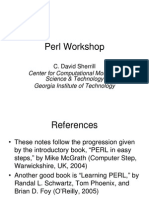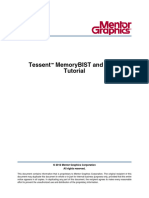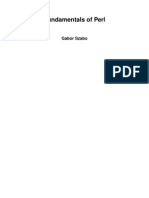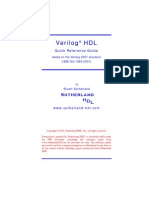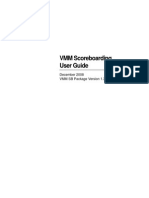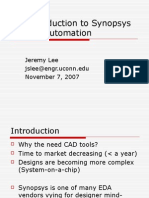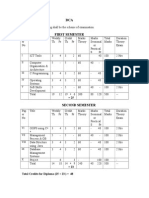0 ratings0% found this document useful (0 votes)
108 viewsPerl Regex
Perl Regex
Uploaded by
noor_dcetThis document discusses Perl regular expressions. It provides slides from a lecture on regular expressions in Perl. The slides cover topics like simple string matching, meta characters, anchored search, character classes, and extracting matches. They provide examples of using regular expressions to extract date/time components from strings in different formats. The slides motivate the use of regular expressions for text parsing and manipulation tasks.
Copyright:
© All Rights Reserved
Available Formats
Download as PDF, TXT or read online from Scribd
Perl Regex
Perl Regex
Uploaded by
noor_dcet0 ratings0% found this document useful (0 votes)
108 views37 pagesThis document discusses Perl regular expressions. It provides slides from a lecture on regular expressions in Perl. The slides cover topics like simple string matching, meta characters, anchored search, character classes, and extracting matches. They provide examples of using regular expressions to extract date/time components from strings in different formats. The slides motivate the use of regular expressions for text parsing and manipulation tasks.
Original Description:
Perl Regex
Copyright
© © All Rights Reserved
Available Formats
PDF, TXT or read online from Scribd
Share this document
Did you find this document useful?
Is this content inappropriate?
This document discusses Perl regular expressions. It provides slides from a lecture on regular expressions in Perl. The slides cover topics like simple string matching, meta characters, anchored search, character classes, and extracting matches. They provide examples of using regular expressions to extract date/time components from strings in different formats. The slides motivate the use of regular expressions for text parsing and manipulation tasks.
Copyright:
© All Rights Reserved
Available Formats
Download as PDF, TXT or read online from Scribd
Download as pdf or txt
0 ratings0% found this document useful (0 votes)
108 views37 pagesPerl Regex
Perl Regex
Uploaded by
noor_dcetThis document discusses Perl regular expressions. It provides slides from a lecture on regular expressions in Perl. The slides cover topics like simple string matching, meta characters, anchored search, character classes, and extracting matches. They provide examples of using regular expressions to extract date/time components from strings in different formats. The slides motivate the use of regular expressions for text parsing and manipulation tasks.
Copyright:
© All Rights Reserved
Available Formats
Download as PDF, TXT or read online from Scribd
Download as pdf or txt
You are on page 1of 37
Universit y of Vict oria
Depart ment of Comput er
Science
SENG 265: Sof t ware Development
Met hods
Perl Regular Expression: Sli de 1
Perl: Regular
expressions
A powerful tool for searching and
transforming text.
Universit y of Vict oria
Depart ment of Comput er
Science
SENG 265: Sof t ware Development
Met hods
Perl Regular Expression: Sli de 2
Mot ivat ion
We have seen many
operat ions involving
st ring comparisons
Several Perl built -in
funct ions also help wit h
operat ions on st rings
split & join
subst r
lengt h
There is a lot we can do
wit h such funct ions
Example:
Given a st ring holding
some t imest amp,
ext ract out different
part s of dat e & t ime
while (my $line = <STDIN>) {
chomp $line;
if ($line eq BEGIN!ST"#T$) {
% &&&
'
'
% &&&
my ($p(ope()y* $+,l-e) = .pli) //* $foo;
if ($p(ope()y eq DST"#T) {
% &&& e)c e)c e)c
'
0c.+1fiel2. = .pli) /*/* $inp-)1line;
$o-)p-) = 3oin $* 02,),;
$fi(.)1ch,( = .-4.)( $inp-)* 5* 6;
$wi2)h = len7)h $he,2in7;
p(in) $he,2in7* 8n
p(in) 9$ : $wi2)h;
Universit y of Vict oria
Depart ment of Comput er
Science
SENG 265: Sof t ware Development
Met hods
Perl Regular Expression: Sli de 3
Mot ivat ion
Recall:
iCalendar dat es are used
by iCal-like programs
The year, mont h, et c.
port ions of t he code are
fixed in posit ion
How could we use subst r
t o help us?
This code cert ainly obt ains
what we need.
But it can be a bit t ricky
t o get right .
Adapt ing code t o use
anot her dat e/t ime format
is not t rivial
and is bugbait !
my $2,)e)ime = ;55<6;;<T5<=555$;
$ye,( = .-4.)( $2,)e)ime* 5* >;
$mon)h = .-4.)( $2,)e)ime* >* ;;
$2,y = .-4.)( $2,)e)ime* ?* ;;
$ho-( = .-4.)( $2,)e)ime* @* ;;
$min = .-4.)( $2,)e)ime* 66* ;;
$.ec = .-4.)( $2,)e)ime* 6=* ;;
% ISA B?56 )ime fo(m,)
my $2,)e)ime = i;55=9659=6T6==C6>95<55$;
$ye,( = .-4.)( $2,)e)ime* 6* <;
$mon)h = .-4.)( $2,)e)ime* C* B;
% coffee 4(e,D
% &&&
$2,y = .-4.)( $2,)e)ime* @* ;;
$ho-( = .-4.)( $2,)e)ime* 6;* ;;
$min = .-4.)( $2,)e)ime* 6>* ;;
$.ec = .-4.)( $2,)e)ime* 6?* ;;
H
a
z
a
r
d
o
u
s
t
o
y
o
u
r
h
e
a
l
t
h
Universit y of Vict oria
Depart ment of Comput er
Science
SENG 265: Sof t ware Development
Met hods
Perl Regular Expression: Sli de 4
Mot ivat ion
A bet t er met hod is t o
indicat e t he st ring s pat t ern
in a way t he reflect s t he
act ual order of pat t ern
component s
The dat e begins at t he
st art of t he st ring.
The year is four digit s.
The mont h follows (t wo
digit s)
and t hen t he day.
The T charact er
separat es t he dat e and
t ime
Hour, minut e and dat e
follow, each t wo digit s
long.
For t he elder Perlmongers:
my ($ye,(* $mon)h* $2,y*
$ho-(* $min-)e* $.econ2)
= $2,)e)ime
=E m{ 8" % .),() of .)(in7
(82{>') % ye,(
(82{;') % mon)h
(82{;') % 2,y
T % li)e(,l T
(82{;') % ho-(
(82{;') % min-)e
(82{;') % .econ2
8F % en2 of .)(in7
':m.;
my $2,)e)ime = ;55<6;;<T5<=555$;
if ($2,)e)ime =E
/G(82{>')(82{;')(82{;')T(82{;')(82{;')(82{;')$/)
{
($ye,(* $mon)h* $2,y* $ho-(* $min* $.ec)
= ($6* $;* $=* $>* $<* $?);
'
Universit y of Vict oria
Depart ment of Comput er
Science
SENG 265: Sof t ware Development
Met hods
Perl Regular Expression: Sli de 5
Mot ivat ion
Back t o our code
modificat ion example
Now we have a different
dat e format
Using a regular
expression, we can
great ly reduce t he
possibilit y of bugs
St ring begins wit h an
i
followed by year
followed by a dash
followed by mont h
et c
my ($ye,(* $mon)h* $2,y*
$ho-(* $min-)e* $.econ2)
= $ic,l12,)e
=E m{ 8" % .),() of .)(in7
i % li)e(,l i
(82{>') % ye,(
9 % li)e(,l 2,.h
(82{;') % mon)h
9 % li)e(,l 2,.h
(82{;') % 2,y
T % li)e(,l T
(82{;') % ho-(
% li)e(,l colon
(82{;') % min-)e
% li)e(,l colon
(82{;') % .econ2
&H % i7no(e (em,in2e(
8F % en2 of .)(in7
':m.;
ISA B?56 )ime fo(m,)
my $2,)e)ime = i;55=9659=6T6==C6>95<55$;
Universit y of Vict oria
Depart ment of Comput er
Science
SENG 265: Sof t ware Development
Met hods
Perl Regular Expression: Sli de 6
Topics
Simple mat ching
Met acharact ers
Anchored search
Charact er classes
Range operat ors in
charact er classes
Mat ching any charact er
Grouping
Ext ract ing Mat ches
Search and Replace
Our coverage of regex synt ax will
be much more slowly paced t hat
t he mot ivat ion just shown!
Previous slides have been
shown t o give you a flavour
of what regular expressions
can achieve.
We will learn how t o
const ruct such expression
over t he next few lect ures.
We have a range of t opics
Regular expressions can seem
complex and crypt ic
However, slow and pat ient
work wit h such expressions
will improve your
product ivit y.
Universit y of Vict oria
Depart ment of Comput er
Science
SENG 265: Sof t ware Development
Met hods
Perl Regular Expression: Sli de 7
Perl Regular Expressions
Perl is renowned for it s
excellence at t ext
processing.
Handling of regular
expressions plays a big
fact or in it s fame.
Mast ering even t he basics
will allow you t o manipulat e
t ext wit h ease.
Regular expressions have a
st rong formalism (FSA).
You have already used
some and seen ot hers.
Ot her languages have
some support for regexes,
usually via some library.
I l. J&c
I p. ,-: K 7(ep .;?<.J$ K le..
L,+,
impo() 3,+,&-)il&(e7e:&J;
My)hon
impo() (e;
N%
-.in7 Sy.)em&Te:)&#e7-l,(E:p(e..ion.;
Universit y of Vict oria
Depart ment of Comput er
Science
SENG 265: Sof t ware Development
Met hods
Perl Regular Expression: Sli de 8
Simple St ring Mat ching
Regular expressions are
usually used in
conjunct ion wit h an if
if < st ring mat ches
t his pat t ern>
... t hen > do
somet hing wit h t hat
mat ch> .
The simplest such mat ch
refers t o a st ring
But not e: t his is much
different t hat using eq
my $line = <SAOEINMPT>;
chomp $line;
% Pn4eDnown.) )o p(o7(,mme(* )he fi(.) line
% of )he inp-) i. )he line Qello* Ro(l2$;
if ($line =E m/Ro(l2/:m.) {
p(in) #e7e:p m,)che.S8n$;
'
el.e {
p(in) Ah* poop&8n$;
'
if ($line eq Ro(l2$) {
p(in) line i. eq-,l )o TRo(l2U8n$;
'
el.e {
p(in) line .-(e ,inU) eq-,l )o TRo(l2U8n$;
'
Universit y of Vict oria
Depart ment of Comput er
Science
SENG 265: Sof t ware Development
Met hods
Perl Regular Expression: Sli de 9
A word about
m/ yadayada/ xms
The t ext bet ween t he t wo slashes is t he regular expression
( regex ).
Leading m indicat es t he regex is used for a mat ch
Trailing xms are t hree regex opt ions
x : Ext ended format t ing (whit espace in regex is ignored)
m : For line boundaries (and eliminat es a cause of some subt le
bugs)
s : ensures everyt hing is mat ched by t he . symbol
Why all of t his verbiage inst ead of plain old /yadayada/ as of
old?
Also not e: m{ } or m//
/UVG88UWJ(X88&VG88UWJ)JU/
m{ T % ,n openin7 .in7le q-o)e
VG88UWJ % ,ny non9.peci,l ch,(.
(X % )hen ,ll of&&
88 & % ,ny e:plici)ly 4,cD.l,.he2 ch,(
VG88UWJ % followe2 4y ,ny non9.peci,l ch,(.
)J % (epe,)e2 Fe(o of m,ny )ime.
T % , clo.in7 .in7le q-o)e
':m.
Universit y of Vict oria
Depart ment of Comput er
Science
SENG 265: Sof t ware Development
Met hods
Perl Regular Expression: Slide 10
Anot her example
The code on t he right
searches for a pat t ern in
some dict ionary file
Not e t hat a command-
line argument is being
used for a regex!
Also not e < > synt ax:
This t akes t he first
unused command-line
argument , and uses it
as a filename for
opening!
%S/-.(/4in/pe(l
-.e .)(ic);
my $(e7e:p = .hif) 0"#G!;
while (my $wo(2 = <>) {
if ($wo(2 =E m/$(e7e:p/:m.) {
p(in) $wo(2;
'
'
I &/.e,(ch&pl p)e( /-.(/.h,(e/2ic)/lin-:&wo(2.
,4(-p)e(
"c,lyp)e(,e
,c,n)hop)e(,n
"c,n)hop)e(i
&&& <.nip> &&&
-nch,p)e(
-nch,p)e(e2
-n2e(p(omp)e(
&&& <.nip> &&&
Yy7op)e(i.
Fy7op)e(on
Fy7op)e(o-.
I
Universit y of Vict oria
Depart ment of Comput er
Science
SENG 265: Sof t ware Development
Met hods
Perl Regular Expression: Slide 11
Met acharact ers
Regexs obt ain t heir power
by describing set s of
st rings.
Such descript ions involve
t he use of
met acharact ers
Of course, some st rings
t hat we want t o mat ch will
cont ain t hese st rings.
Therefore we must
escape t hem.
{ ' V W ( )
G $ &
K J X
/ 8
;H;=>$ =E m/;H;/:m. % 2oe.nU) m,)ch
;H;=>$ =E m/;8H;/:m. % 2oe. m,)ch
The in)e(+,l i. V5*6)&$ =E
m/V5*6)&/:m. % .yn),: e((o(
The in)e(+,l i. V5*6)&$ =E
m/8V5*68)8&/:m. % 2oe. m,)ch
/-.(/4in/pe(l$
=E m/8/-.(8/4in/8/pe(l/:m. % m,)che.
/-.(/4in/pe(l$
=E m{/-.(/4in/pe(l':m. % 4e))e(
TN8RINDARSU =E m/N88RINDARS/ % m,)che.
Universit y of Vict oria
Depart ment of Comput er
Science
SENG 265: Sof t ware Development
Met hods
Perl Regular Expression: Slide 12
Anchoring
We may wish t o anchor a mat ch t o cert ain
locat ions
^ mat ches t he beginning of a line.
$ mat ches t he end of a line.
\A mat ches t he beginning of a st ring.
\z mat ches t he end of a st ring.
ho-.eDeepe($ =E m/Deepe(/:m. % m,)che.
ho-.eDeepe($ =E m/GDeepe(/:m. % 2oe. no) m,)ch
ho-.eDeepe($ =E m/Deepe(/:m. % m,)che.
ho-.eDeepe($ =E m/Deepe(8n/:m. % ,l.o m,)che.
Deepe($ =E m/GDeep$/:m. % 2oe. no) m,)ch
Deepe($ =E m/GDeepe($/:m. % m,)che.
Deepe($ =E m{8" Deepe( 8F':m. % m,)che.
my $)e:) =ZQe(e i. one line&8nI) i. followe2 4y8n"no)he( lineS8nZ;
if ($)e:) =E m{line8& $':) { p(in) ZGo)ch,8nZ; ' el.e { p(in) ZAh 2e,(8nZ; '
if ($)e:) =E m{line8& $':m) { p(in) ZGo)ch,8nZ; ' el.e { p(in) ZAh 2e,(8nZ; '
Universit y of Vict oria
Depart ment of Comput er
Science
SENG 265: Sof t ware Development
Met hods
Perl Regular Expression: Slide 13
Charact er classes
These allow
set s of
possible
charact ers
t o be
mat ched
Used at
desired
point s wit hin
a regex.
m/c,)/:m. % m,)che. Tc,)U
m/V4c(W,)/:m. % m,)che. T4,)* Tc,)U* o( T(,)U
m/i)emV56;=><?CB@W/:m. % m,)che. Ti)em5U* && Ti)em@U
,4c$ =E m/Vc,4W/:m. % m,)che. T,U
m/Vy[WVeEWV.SW/:m. % m,)che. c,.e9in.en.i)i+e [ES
m/ye./:m.i % .imple( w,y* -.in7 i$
m/(Xi)ye./:m. % .,me
m/V8WcW2ef/:m. % m,)che. TW2efU o( Tc2efU
$: =T4c(U
m/V$:W,)/:m. % m,)che. T4,)U* Tc,)U* T(,)U
m/V8$:W,)/:m. % m,)che. T$,)U o( T:,)U
m/V88$:W,)/:m. % m,)che. T8,)U* T4,)* Tc,)U*
o( T(,)U
Universit y of Vict oria
Depart ment of Comput er
Science
SENG 265: Sof t ware Development
Met hods
Perl Regular Expression: Slide 14
Range operat ors
Ranges can
eliminat e some
ugly code
[ 0123456789]
becomes [ 0-9]
[ abcdefghijklmnopqrs
t uvwxyz] becomes [ a-
z]
If - is t he first or last
charact er in a charact er
class, it is t reat ed as an
ordinary charact er
m/i)emV59@W/:m. % i)em5* i)em6* &&& i)em@
m/V59@4:9FW,,/:m. % T5,,U* &&&* T@,,U*
% T4,,U* T:,,U* Ty,,U*
% o( TF,,U
m/V59@,9f"9\W/:m. % m,)che. he: 2i7i)
m/V,9FW/i % m,)che. , wo(2$ ch,(
% ,ll ,(e eq-i+,len)
m/V9,4W/:m.
m/V,49W/:m.
/V,894W/:m.
Universit y of Vict oria
Depart ment of Comput er
Science
SENG 265: Sof t ware Development
Met hods
Perl Regular Expression: Slide 15
Negat ed charact er
classes
The special charact er
^ in t he first posit ion
of a charact er class
denot es a negat ed
charact er class
Mat ches any charact er
but t hose in t he
bracket s
m/[a]at/xms
# doesnt match aat or at, but
# matches all other bat, cat,
# 0at, %at, etc.
m/[0!]/xms
# matches a nonnumer"c character
m/[a]at/xms
# matches aat or at# here
# "s ord"nary
Universit y of Vict oria
Depart ment of Comput er
Science
SENG 265: Sof t ware Development
Met hods
Perl Regular Expression: Slide 16
Mat ching any charact er
The period '. ' mat ches any charact er but "\n"
A period is a met acharact er, it needs t o be
escaped t o mat ch as an ordinary period.
m/..rt/xms # matches any $ chars, %ollo&ed by rt
m/end'./xms # matches end.
m/end[.]/xms # same th"n(, matches only end.
)) *+ m/./xms # doesnt match needs a character
)a) *+ m/.,/xms # matches
)) *+ m/.,/xms # doesnt match needs a character
)'n) *+ m/.,/xms # doesnt match needs a character
# other than 'n
)a'n) *+ m/.,/xms # matches, "(nores the 'n
Universit y of Vict oria
Depart ment of Comput er
Science
SENG 265: Sof t ware Development
Met hods
Perl Regular Expression: Slide 17
Mat ching t his or t hat
We would like t o mat ch different
possible words or charact er st rings
We use t he alt ernat ion charact er |
(pipe)
"cats and dogs" = /cat|dog|bird/ # matches "cat"
"cats and dogs" = /dog|cat|bird/ # matches "cat"
Universit y of Vict oria
Depart ment of Comput er
Science
SENG 265: Sof t ware Development
Met hods
Perl Regular Expression: Slide 18
Grouping Things
Toget her
Somet imes we want alt ernat ives for part of a
regular expression.
/(a|b)b/ # matches ab or bb
/(ac|b)b/ # matches acb or bb
/(a|b)c/ # matches ac at start of string or
# bc anywhere
/(a|[bc])d/ # matches ad, bd, or cd
/house(cat|)/ # matches either housecat
# or house
/house(cat(s|)|)/ # matches either housecats or
# housecat or house.
# Note groups can be nested.
Universit y of Vict oria
Depart ment of Comput er
Science
SENG 265: Sof t ware Development
Met hods
Perl Regular Expression: Slide 19
Ext ract ing Mat ches
The grouping met acharact ers () also serve anot her
complet ely different funct ion: t hey allow t he ext ract ion of
t he part s of a st ring t hat mat ched.
For each grouping, t he part t hat mat ched inside goes int o
t he special variables $1, $2, et c.
# extract hours, minutes, seconds
$time = /(\d\d):(\d\d):(\d\d)/ # match hh:mm:ss format
# \d is equivalent to [0-9]
$hours = $1;
$minutes = $2;
$seconds = $3;
# More compact code, equivalent code
($hours,$minutes,$second) = ($time =/(\d\d):(\d\d):
(\d\d)/)
Universit y of Vict oria
Depart ment of Comput er
Science
SENG 265: Sof t ware Development
Met hods
Perl Regular Expression: Slide 20
Mat ching Repet it ions
We would like t o be able t o mat ch mult iple t imes:
a? = mat ch ' a' 0 or 1 t imes (~ opt ional)
a* = mat ch ' a' 0 or more t imes, i.e., any number of t imes
a+ = mat ch ' a' 1 or more t imes, i.e., at least once
a{n,m} = mat ch at least n t imes, but not more t han m
t imes.
a{n,} = mat ch at least n or more t imes.
a{n} = mat ch exact ly n t imes
$year = /\d{2,4}/ # make sure year is at least 2 but
# not more than 4 digits
/[a-z]+\d*/i # match a word and any number of digits
/y(es)?/i # matches y, Y,
# or a case-insensitive yes
Universit y of Vict oria
Depart ment of Comput er
Science
SENG 265: Sof t ware Development
Met hods
Perl Regular Expression: Slide 21
Search and Replace
Regular expressions also play a role in
search and replace operat ions in Perl
Search and replace is accomplished
wit h t he s/// operat or
General form:
s/regexp/replacement/modi ers
$x = "Time to feed the cat!";
if ( $x = s/cat/hamster/ ) {
print $x; # Time to feed the hamster!
}
Universit y of Vict oria
Depart ment of Comput er
Science
SENG 265: Sof t ware Development
Met hods
Perl Regular Expression: Slide 22
More Search and Replace
Commands
$y = "'quoted words'";
$y = s/'(.*)'$/<<$1>>/ # strip single quotes, $y
# contains "<<quoted words>>"
$x = "I batted 4 for 4";
$x = s/4/four/ # doesnt do it all:
# $x contains
# "I batted four for 4
$x = "I batted 4 for 4";
$x = s/4/four/g # /g modifier does it all:
# $x contains
# "I batted four for four"
Universit y of Vict oria
Depart ment of Comput er
Science
SENG 265: Sof t ware Development
Met hods
Perl Regular Expression: Slide 23
A f ew more regexp
t opics
Advanced uses of mat ches
Escape sequences
List and scalar cont ext , e.g., phone
numbers
Finding all inst ances of a mat ch
Parent hesis
Subst it ut ing wit h s///
t r, t he t ranslat e funct ion
Universit y of Vict oria
Depart ment of Comput er
Science
SENG 265: Sof t ware Development
Met hods
Perl Regular Expression: Slide 24
Advanced uses of
mat ches
You can assign pat t ern memory
direct ly t o your own variable
names (capt uring):
($phone) = $value =~ /^phone\:(.+)$/;
Read from right t o left . Apply t his pat t ern
t o t he value in $value, and assign t he
result s t o t he list on t he left .
($front,$back) = /^phone\:(\d{3})-(\d{4})/;
Apply t his pat t ern t o $_ and assign t he
result s t o t he list on t he left .
Universit y of Vict oria
Depart ment of Comput er
Science
SENG 265: Sof t ware Development
Met hods
Perl Regular Expression: Slide 25
Meaning of backslash let t ers
\n : newline
\r: carriage ret urn
\t : t ab
\f: formfeed
\d: a digit (same as [ 0-9] )
\D: a non-digit
\w: an alphanumeric charact er, same as [ 0-9a-z_A-
Z]
\W: a non-alphanumeric charact er
\s: a whit espace charact er, same as [ \t \n\r\f]
\S: a non-whit espace charact er
Universit y of Vict oria
Depart ment of Comput er
Science
SENG 265: Sof t ware Development
Met hods
Perl Regular Expression: Slide 26
Reminder: list or scalar
cont ext ?
A pat t ern mat ch ret urns 0 (false) or 1 (t rue) in
scalar cont ext , and a list of mat ches in array
cont ext .
Recall: There are a lot of funct ions t hat do
different t hings depending on whet her t hey are
used in scalar or list cont ext .
# returns the number of elements
$count = @array
# returns a reversed string
$revString = reverse $string
# returns a reversed list
@revArray = reverse @array
You must always be caut ious of t his behaviour.
Universit y of Vict oria
Depart ment of Comput er
Science
SENG 265: Sof t ware Development
Met hods
Perl Regular Expression: Slide 27
Pract ical Example of
Cont ext
$phone = $string =~ /^.+\:(.+)$/;
$phone cont ains 1 if pat t ern mat ches,
0 ot herwise
($phone) = $string =~ /^.+\:(.+)$/;
$phone cont ains t he mat ched st ring
Universit y of Vict oria
Depart ment of Comput er
Science
SENG 265: Sof t ware Development
Met hods
Perl Regular Expression: Slide 28
Finding all inst ances of a
mat ch
Use t he g modifier wit h a regular
expression
@sites = $sequence =~ /(TATTA)/g;
t hink g for global
Ret urns a list of all t he mat ches (in
order), and st ores t hem in t he array
If you have n pairs of parent heses,
t he array looks like t he following:
] ($6*$;*^$n*$6*$;*^$n*^)
Universit y of Vict oria
Depart ment of Comput er
Science
SENG 265: Sof t ware Development
Met hods
Perl Regular Expression: Slide 29
Perl is Greedy
Perl regular expressions t ry t o mat ch t he
largest possible st ring which mat ches your
pat t ern:
lalaaaaagag =~ /(la.*ag)/
/la.*ag/ mat ches laag, lalag, laaaaaag
$1 cont ains lalaaaaagag
If t his is not what you want ed t o do, use t he
? modifier:
lalaaaaagag =~ /(la.+?ag)/
/(la.+?ag)/ mat ches as few charact ers
as possible t o find mat ching pat t ern
$1 cont ains lalaaaaag
Universit y of Vict oria
Depart ment of Comput er
Science
SENG 265: Sof t ware Development
Met hods
Perl Regular Expression: Slide 30
Making parent heses
f orget f ul
Somet imes you need parent heses t o make your
regular expression work, but you don t act ually want
t o keep t he result s. You can st ill use parent heses for
grouping.
/(?:group)/
Cert ain charact ers are overloaded; recall:
\d? means 0 or 1 inst ances
\d+? means t he fewest non zero number of
digit s
(?:group) means look for t he group of
at oms in t he st ring, but don t remember
t hem
Universit y of Vict oria
Depart ment of Comput er
Science
SENG 265: Sof t ware Development
Met hods
Perl Regular Expression: Slide 31
Example of f orget t ing
#!/usr/bin/perl
# Method 1
if (@ARGV && $ARGV[0] eq "-x") {
$mod = "?:";
} else {
$mod = "";
}
$pat1 = "\\w+";
$pat2 = "\\d+";
while (<STDIN>) {
$_ =~ /($mod$pat1) ($pat2)/;
print $1, "\n";
}
#!/usr/bin/perl
# Method 2
if (@ARGV && $ARGV[0] eq "-x") {
$ignore = 1;
} else {
$ignore = 0;
}
while (<STDIN>) {
$_ =~ /(\w+) (\d+)/;
if ($ignore) {
print $2, "\n";
}
else {
print $1, "\n";
}
}
Universit y of Vict oria
Depart ment of Comput er
Science
SENG 265: Sof t ware Development
Met hods
Perl Regular Expression: Slide 32
More examples using
.///
Subst it ut ing one word for anot her
$string =~ s/dogs/cats/
If $string was I love dogs , it is now I love cat s
Removing t railing whit e space
$string =~ s/\s+$//
If $string was ATG , it is now ATG
Adding 10 t o every number in a st ring
$string =~ /(\d+)/$1+10/ge
Not e pat t ern memory
g means global (just like in regular expressions)
e is specific t o s, evaluat e t he expression on t he right
Universit y of Vict oria
Depart ment of Comput er
Science
SENG 265: Sof t ware Development
Met hods
Perl Regular Expression: Slide 33
tr f unct ion
t ranslat e or t ranslit erat e
] Gene(,l fo(m
tr/list1/list2/
Even less like a regular expression t han
s
subst it ut es charact ers in t he first list
wit h charact ers from t he second list :
$string =~ tr/a/A/
every a t o t ranslat ed t o an A
No need for a global modifier using tr.
Universit y of Vict oria
Depart ment of Comput er
Science
SENG 265: Sof t ware Development
Met hods
Perl Regular Expression: Slide 34
More examples of tr
convert ing named scalar t o lowercase
$ARGV[1] =~ tr/A-Z/a-z/
count t he number of * in $_
$cnt = tr/*/*/
$cnt = $_ =~ tr/*/*/
change all non-alphabet ic charact ers t o
spaces
tr/a-zA-Z/ /c
not ice space + c = complement search st ring
delet e all non-alphabet ic charact ers complet ely
tr/a-zA-Z//cd
d = delet e found but unreplaced charact ers
Universit y of Vict oria
Depart ment of Comput er
Science
SENG 265: Sof t ware Development
Met hods
Perl Regular Expression: Slide 35
Using t he result s of mat ches
wit hin a pat t ern
\1, \2, \3 refer t o what a previous set of
parent heses mat ched
abc abc =~ /(\w+) \1/ # matches
abc def =~ /(\w+) \2/ # doesnt match
Can also use $1, $2, et c. t o perform some
int erest ing operat ions:
s/^([^ ]*) *([^ ]*)/$2 $1/ #swap first two words
/(\w+)\s*=\s*\1/ # match foo = foo
ot her default variables used in mat ches
$` : ret urns everyt hing before mat ched st ring
$& : ret urns ent ire mat ched st ring
$ : ret urns everyt hing aft er mat ched st ring
Universit y of Vict oria
Depart ment of Comput er
Science
SENG 265: Sof t ware Development
Met hods
Perl Regular Expression: Slide 36
Example: Celsius
Fahrenheit
#! /usr/bin/perl -w
print "Enter temperature: \n";
$line = <STDIN>;
chomp($line);
if ( $line =~ /^([-+]?[0-9]+(?:\.[0-9]*)?)\s*([CF])$/i ) {
$temp = $1;
$scale = $2;
if ( $scale =~ /c/i ) {
$cel = $temp;
$fah = ($cel * 9 / 5) + 32;
}
else {
$fah = $temp;
$cel = ($fah - 32) * 5 / 9;
}
printf( "%.2f C is %.2f F\n", $cel, $fah );
}
else {
printf( "Bad format\n" );
}
Universit y of Vict oria
Depart ment of Comput er
Science
SENG 265: Sof t ware Development
Met hods
Perl Regular Expression: Slide 37
Regex on command line
We can execut e simple regular
expressions on t he command line:
$ perl p i e 's/kat/cat/g' in.txt
p : apply program t o each line in file
in.txt
i : writ e changes back t o in.txt
e : program bet ween ''
You might also like
- Perl Interview QuestionsDocument25 pagesPerl Interview QuestionsVarun PNo ratings yet
- Perl WorkshopDocument68 pagesPerl WorkshopVenkat Kiran Sribhashyam100% (1)
- Dancer2 OdpDocument42 pagesDancer2 OdpYVS PRASADNo ratings yet
- 10 JavaScript Coding ExercisesDocument11 pages10 JavaScript Coding Exercisespgkalex455No ratings yet
- Perl Dbi DpriestDocument45 pagesPerl Dbi Dpriestmottur1984100% (1)
- Practical Extraction and Reporting LanguageDocument45 pagesPractical Extraction and Reporting LanguageitanilmitsNo ratings yet
- Ece5950 Tut4 Vcs GLDocument5 pagesEce5950 Tut4 Vcs GLVijay Kumar NNo ratings yet
- Menor Tessent MBIST Day1 TutorialDocument26 pagesMenor Tessent MBIST Day1 Tutorial3122647764No ratings yet
- Perl: A Crash Course: Brent Yorgey Winter Study '03Document28 pagesPerl: A Crash Course: Brent Yorgey Winter Study '03toronto_guyNo ratings yet
- Object Oriented Perl 2000Document510 pagesObject Oriented Perl 2000Riddhi VamjaNo ratings yet
- Excel VBA FindDocument21 pagesExcel VBA FindHemalatha S KumarNo ratings yet
- Genus Synthesis Solution DsDocument3 pagesGenus Synthesis Solution DsHistPro WebNo ratings yet
- Are Advanced Verification Methodologies Required To Test FPGA Designs?Document4 pagesAre Advanced Verification Methodologies Required To Test FPGA Designs?Nitu VlsiNo ratings yet
- Equivalence CheckingDocument22 pagesEquivalence CheckingINGALE PRATAP ASHOKNo ratings yet
- Uvm Day 1 PDFDocument34 pagesUvm Day 1 PDFShobithNo ratings yet
- Key Concerns For Verifying Socs: Figure 1: Important Areas During Soc VerificationDocument5 pagesKey Concerns For Verifying Socs: Figure 1: Important Areas During Soc Verificationsiddu. sidduNo ratings yet
- Perl Programming Exercises 1 - 'A B C'Document29 pagesPerl Programming Exercises 1 - 'A B C'Murali Mohan ReddyNo ratings yet
- SimVisionAdvancedRAK OverviewDocument116 pagesSimVisionAdvancedRAK Overviewkarimyossef1001No ratings yet
- Lab2 SynthesisDocument27 pagesLab2 Synthesisnhân đặngNo ratings yet
- Vlsi Interview Back EndDocument31 pagesVlsi Interview Back EndKshitij GoelNo ratings yet
- Fundamentals of PerlDocument142 pagesFundamentals of Perlapi-3763897100% (1)
- Verilog 2001 Ref GuideDocument56 pagesVerilog 2001 Ref GuideIzi PajkNo ratings yet
- (Synopsys) VMM Scoreboard Guide (2008)Document164 pages(Synopsys) VMM Scoreboard Guide (2008)JohnNo ratings yet
- Reuse of SV-UVM Based IP Verification Environment at SoC - Challenges InvolvedDocument15 pagesReuse of SV-UVM Based IP Verification Environment at SoC - Challenges InvolvedKrishna Unv100% (1)
- 2013 SNUG SV - Synthesizable SystemVerilog - Presentation PDFDocument31 pages2013 SNUG SV - Synthesizable SystemVerilog - Presentation PDFsureshchandraNo ratings yet
- Verilog 2012Document70 pagesVerilog 2012Bach TrungNo ratings yet
- SV Interview QuestionsDocument51 pagesSV Interview QuestionsyaminiNo ratings yet
- IHI0024C Amba Apb Protocol SpecDocument28 pagesIHI0024C Amba Apb Protocol SpecAnil KumarNo ratings yet
- AVMSVI-04 - Automating Testbench Tasks With TCLDocument26 pagesAVMSVI-04 - Automating Testbench Tasks With TCLGurinder Pal SinghNo ratings yet
- Verif Plan CmptsDocument35 pagesVerif Plan CmptsBach HoangNo ratings yet
- AI Transformation PlaybookDocument22 pagesAI Transformation PlaybookOdun Adetola AdeboyeNo ratings yet
- GCD FlowDocument34 pagesGCD Flowsudhakar kandiNo ratings yet
- Training Tutorial Jaspergold® Apps Property Visualization and DebuggingDocument26 pagesTraining Tutorial Jaspergold® Apps Property Visualization and DebuggingmadhukirNo ratings yet
- Tessent Integrated Flow Lab3 Basic Block-Based Bottom-Up DFT Flow OverviewDocument10 pagesTessent Integrated Flow Lab3 Basic Block-Based Bottom-Up DFT Flow OverviewBryan FallasNo ratings yet
- Part I ! Introduction To Perl Scripting: Dr. K. NajeebDocument85 pagesPart I ! Introduction To Perl Scripting: Dr. K. Najeebsri4560No ratings yet
- LEC Jumpstart Training OverviewDocument37 pagesLEC Jumpstart Training OverviewSumanth VarmaNo ratings yet
- An Introduction To Synopsys Design AutomationDocument24 pagesAn Introduction To Synopsys Design Automationprathap13No ratings yet
- Chapter4 Verilog SimulationDocument68 pagesChapter4 Verilog SimulationbigfatdashNo ratings yet
- Memory BIST TutorialDocument22 pagesMemory BIST TutorialKrish GokulNo ratings yet
- CummingsSNUG2014AUS UVM MessagesDocument33 pagesCummingsSNUG2014AUS UVM MessagesKalpana ChaudharyNo ratings yet
- Axi SlaveDocument9 pagesAxi SlaveNishant SaksenaNo ratings yet
- Atpg and Coverage AnalysisDocument4 pagesAtpg and Coverage AnalysisKavitha KumariNo ratings yet
- CPF UserDocument207 pagesCPF UseremmasustechNo ratings yet
- Chap 1 VerilogDocument7 pagesChap 1 VeriloglordfiendNo ratings yet
- DFT Compiler Scan User Guide: Version D-2010.03-SP2, June 2010Document515 pagesDFT Compiler Scan User Guide: Version D-2010.03-SP2, June 2010Amena FarhatNo ratings yet
- Debugging SystemVerilogDocument175 pagesDebugging SystemVerilog조동올No ratings yet
- Programming On The Web (Csc309F) : Website: Office-Hour: Friday 12:00-1:00 (Sf2110) Email: Wael@Cs - Toronto.EduDocument12 pagesProgramming On The Web (Csc309F) : Website: Office-Hour: Friday 12:00-1:00 (Sf2110) Email: Wael@Cs - Toronto.EdunscintaNo ratings yet
- R: Creating Graphical User Interfaces (Guis) Using The TCLTKDocument21 pagesR: Creating Graphical User Interfaces (Guis) Using The TCLTKharshanagaraj14No ratings yet
- Cs Class 12th Notes KVDocument283 pagesCs Class 12th Notes KVasmee17860No ratings yet
- Scheme and Syllabi For Sixth Semester CSEDocument15 pagesScheme and Syllabi For Sixth Semester CSEAnoop K VenuNo ratings yet
- Whole School Curriculum OverviewDocument4 pagesWhole School Curriculum Overviewapi-238812781No ratings yet
- Total Credits For Diploma (25 + 23) 48Document16 pagesTotal Credits For Diploma (25 + 23) 48arundhathinairNo ratings yet
- C - Question Paper Quark Media House India Pvt. LTD.: 1. What Is The Output of The Following CodeDocument9 pagesC - Question Paper Quark Media House India Pvt. LTD.: 1. What Is The Output of The Following CodesumikannuNo ratings yet
- Lecture Eight (Notes) - DocumentationDocument8 pagesLecture Eight (Notes) - DocumentationgdeepthiNo ratings yet
- Tetramax Lab 1: Automatic Test Pattern Generation (ATPG) : Computer-Aided VLSI System DesignDocument4 pagesTetramax Lab 1: Automatic Test Pattern Generation (ATPG) : Computer-Aided VLSI System DesignJeevith PaulNo ratings yet
- Syllabi For Common Courses: Course I: Communication Skills in EnglishDocument18 pagesSyllabi For Common Courses: Course I: Communication Skills in EnglishLinn AbrahamNo ratings yet
- Core Java NotesDocument39 pagesCore Java NotesAnonymous BOreSFNo ratings yet
- University SyllabusDocument129 pagesUniversity SyllabusHari NarayananNo ratings yet
- Variable Assignment Accessing Variable Values: """ """ # Line CommentDocument1 pageVariable Assignment Accessing Variable Values: """ """ # Line CommentdypthaNo ratings yet
- Dotnet QuesansDocument7 pagesDotnet QuesansAravind BhomboreNo ratings yet
- Conversion From Boolean Logic To Layout DesignDocument31 pagesConversion From Boolean Logic To Layout Designnoor_dcetNo ratings yet
- pdf2 PDFDocument8 pagespdf2 PDFnoor_dcetNo ratings yet
- Sva QuickrefDocument31 pagesSva Quickrefnoor_dcetNo ratings yet
- Arth CirDocument105 pagesArth Cirnoor_dcetNo ratings yet
- Perl RegexDocument37 pagesPerl Regexnoor_dcetNo ratings yet
- DFT Test Point InsertionDocument21 pagesDFT Test Point Insertionnoor_dcet100% (1)
- Application of StackDocument3 pagesApplication of Stacknoor_dcetNo ratings yet
- Synopsys Vcs/Vcsi Tutorial: Watch DesignDocument21 pagesSynopsys Vcs/Vcsi Tutorial: Watch Designnoor_dcetNo ratings yet
- Semiconductor Device FundamentalsDocument13 pagesSemiconductor Device Fundamentalsnoor_dcet0% (4)
- DFT ProtocolDocument33 pagesDFT Protocolnoor_dcet100% (1)
- DFT ProtocolDocument33 pagesDFT Protocolnoor_dcet100% (1)
- DFT 2006.06 SG 02 UiDocument34 pagesDFT 2006.06 SG 02 Uinoor_dcetNo ratings yet
- DFT 2006.06 SG 00 IntroDocument24 pagesDFT 2006.06 SG 00 Intronoor_dcetNo ratings yet

